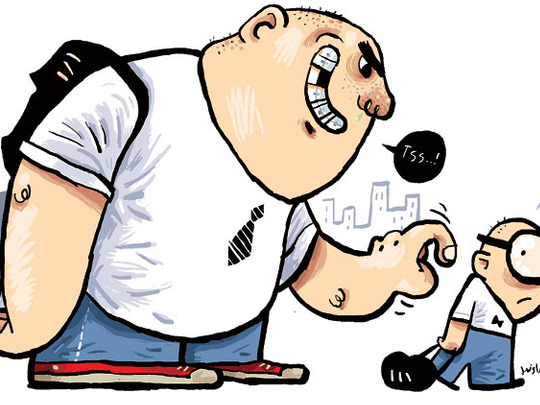
When a child is bullied, who is at fault? Is it nature or nuture that makes a bully? Given that parental influences play such a powerful role in shaping the behaviour of a child, where does bullying fit in? Is it fair for parents to wipe their hands off the blame by pointing fingers at influences outside of themselves?
“Children bully for a variety of different reasons,” explains Dr Amy Bailey, Clinical Psychologist at the kidsFIRST Medical Centre, Dubai. “However, these reasons most commonly stem from the experiences that the child has had. When an infant is born, the brain has not made any neural connections. These connections are made based on the experiences that a child has and teach the brain how to respond to different situations (e.g. children who have grown up in a frightening environment have brains that are hardwired to recognise stress and can more easily react with a fight or flight response to situations that others may see as unthreatening).”
Most children who bully have witnessed this behaviour within some area of their life – this may be aggressive or dominating behaviour from a parent or other adult, or they have been the victim of a bully themselves.
As such, they think their bullying behaviour a perfectly acceptable way to communicate and interact with others. “Children are always watching and therefore we need to be mindful when dealing with our own frustrations and angers that we are modelling to our child appropriate ways in which to do this.”
Sometimes children bully to hide their own feelings of inadequacy. “They do not want other children to become more popular, or to do better than them. By devaluating others they hope to increase their own self-worth in the eyes of their peers.”
Children may also bully others who are different to themselves. This stems from a lack of understanding and fear about someone who is different. “In the UAE, children are exposed to a huge mix of cultures and nationalities therefore we need to teach children about difference from a young age so that this is not something that they are fearful of.”
Anagha Mulay, student counsellor at Delhi Private School Sharjah (CBSE school), strongly believes love is the missing link. “Children need time and attention. Sometimes they get so frazzled by the lack of attention that they find any kind of attention is better than none. A child is more likely to become a bully if they belong to a home that lacks warmth and loving. Also, they could be dealing with negative beliefs about their own self-worth and due to the limited time that they get as a family they get a sense of self-importance by imposing on others.”
In other words, they lack positive reinforcement from their parents and therefore have developed negative core beliefs about themselves and need to seek out other ways to help feel better about themselves.
Children who experience inconsistent care and discipline and/or live within a punitive environment are also more likely to become bullies. “Such children tend to experience significant anxiety as their home environment is quite unpredictable. They therefore use bullying behaviour to try to feel more in control and tend to enjoy the feeling of having power over others which can balance out the feelings of powerlessness or ineffectiveness that they are likely to experience at home,” she adds.
Some of the major influencers that can lead to children viewing bullying as an acceptable attitude:
1) Parenting patterns
“Another cause of concern is when the parents are permissive. A child growing up without rules or guidelines does whatever he pleases. They do not have an understanding of direction, respect for the rights of others, or their own responsibilities. Sadly, such parents don’t understand the seriousness of this waywardness and often do not attempt to stop the cycle of bullying that the child can possibly get into.”
Parents need to find a balance in their parenting style. Both authoritarian and permissive parenting styles can leave children in danger of either becoming a bully or being the target of one.
“Research suggests that the highest family risk factors for bullying are: A lack of warmth and involvement on the part of parents, overly permissive parenting (including a lack of limits for children’s behaviour), a lack of supervision by parents, Harsh, physical discipline and bullying incidences at home,” Dr Bailey pointed out.
2) Sibling influences
Sibling relationships are lifelong relationships. They significantly impact an individual’s development. It’s normal and expected for some amount of conflict within this relationship. Parents can use the understanding of this relationship to provide a positive context for learning social skills and for understanding other people’s emotions and perspectives.
“Birth order impacts sibling relationships. Parents are more protective and in control of the first born. They get undivided attention and care before their sibling is born. They are therefore more submissive to authority. In response they could become aggressive towards their younger ones. Often when a younger sibling is born, the elder one feels left out and unimportant. Parents must be careful to keep jealousy at bay. It should be properly managed or it can bitterly impact sibling relationship on a long term,” stressed Mulay.
Research suggests that having an older sibling who is getting into trouble puts younger siblings at greater risk of engaging in negative behaviours themselves. A younger sibling learns bullying behaviour by observing this behaviour in their older sibling. If they are the victim of this themselves, then they may turn to bullying others as a way to compensate for the negative feelings this creates.
3) Peer pressure
“Studies looking at the influence of peer groups on bullying behaviour tend to support the “homophily hypothesis”, which holds that an individual’s behaviour is influenced by the groups they are part of,” said Dr Bailey. “Children who hang out with peers who bully, both boys and girls, tend to do more bullying themselves. Research has indicated that even when individual students engage in little or no bullying, they often rarely intervene to stop bullying and seem to largely accept it.
Often children who do bully seem to have large support network of friends. Often this perpetuates the bullying as they receive positive reinforcement in the form of respect as well as fear from others which increases the likelihood of them engaging in similar behaviour again in the future.
4) Gender aspect
Bullying is not a gender related issue. Both boys and girls bully, but their patterns vary. “While boys can be more physically aggressive and violent girls can hit on the emotional front. Pushing, hitting is often considered cool for boys; while girls tend to bully by spreading rumours, passing sexual comments and even cornering or grouping the odd one out. Each has its own degree of hurt and damage. It can leave the victim socially isolated and unconfident in their understanding of self,” Mulay added.
4) Understand the signs
Children who bully can show a number of different traits. Generally, they can be impulsive and hot-headed, dominant in their interactions, and can become easily frustrated. Children who bully tend to lack in empathy for others, have difficulty following rules, view violence in a positive way and can present a defiant or hostile attitude, taking offence quite easily. Underneath this exterior however, children who bully are often far from confident and are likely to be highly insecure and anxious.
Behaviours that you may see in a child who bullies are frequent name-calling, regular bragging and boasting, a need to be in control and to always get their own way. They may also prefer to spend time with younger or less powerful kids.
“Some children do not even realise how much their behaviour is affecting others. They may see it is being cool. These children need to learn how to sympathise with others. Often they can be prevented from bullying others by learning to treat others with respect,” says Sudanese Hind Al Wahab, an Arabic teacher who is in charge of a middle school boys’ class.
It is important to teach children to recognise that there are other people who are less fortunate than themselves that need our help and support. Engaging your child with community or charity projects (such as volunteering) can help teach your child why it is important to help and support others. Not only does this help to build respect it also makes the child feel good about themselves for doing something worthwhile and valuable.
“School-based programmes aimed at targeting bullying need to consider not only the individual reasons as to why a child may bully but also need to target bullying as a “group process”.
As such, interventions against bullying should be targeted at the peer-group level rather than solely at individual bullies and victims,” says Jyothi Mahtani, Indian who teaches at the primary wing of Wesgreen International School.
The school recently held special assemblies where teachers enacted bullying scenarios to highlight the impact of such behaviours on both the one being bullied and the one who is bullying.
“It’s easy to reach out to a child. You just need to relate to them at their level. We showed them what they had probably already seen but the assemblies opened a channel and the students felt at ease to come up to us and voice their concerns if any.”












